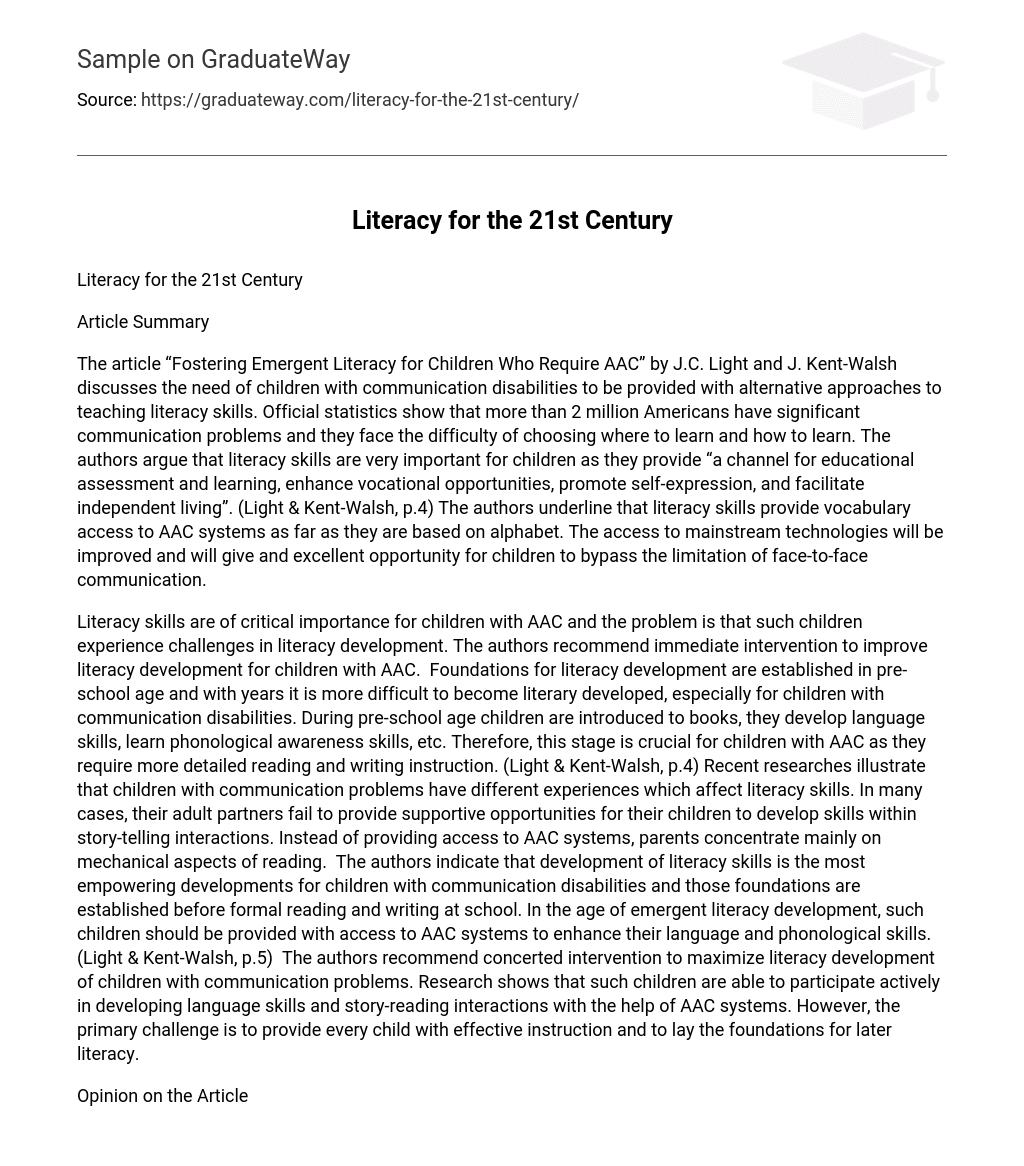The article “Fostering Emergent Literacy for Children Who Require AAC” by J.C. Light and J. Kent-Walsh discusses the need of children with communication disabilities to be provided with alternative approaches to teaching literacy skills. Official statistics show that more than 2 million Americans have significant communication problems and they face the difficulty of choosing where to learn and how to learn.
The authors argue that literacy skills are very important for children as they provide “a channel for educational assessment and learning, enhance vocational opportunities, promote self-expression, and facilitate independent living”. (Light & Kent-Walsh, p.4) The authors underline that literacy skills provide vocabulary access to AAC systems as far as they are based on alphabet. The access to mainstream technologies will be improved and will give and excellent opportunity for children to bypass the limitation of face-to-face communication.
Literacy skills are of critical importance for children with AAC and the problem is that such children experience challenges in literacy development. The authors recommend immediate intervention to improve literacy development for children with AAC. Foundations for literacy development are established in pre-school age and with years it is more difficult to become literary developed, especially for children with communication disabilities. During pre-school age children are introduced to books, they develop language skills, learn phonological awareness skills, etc. Therefore, this stage is crucial for children with AAC as they require more detailed reading and writing instruction. (Light & Kent-Walsh, p.4)
Recent researches illustrate that children with communication problems have different experiences which affect literacy skills. In many cases, their adult partners fail to provide supportive opportunities for their children to develop skills within story-telling interactions. Instead of providing access to AAC systems, parents concentrate mainly on mechanical aspects of reading.
The authors indicate that development of literacy skills is the most empowering developments for children with communication disabilities and those foundations are established before formal reading and writing at school. In the age of emergent literacy development, such children should be provided with access to AAC systems to enhance their language and phonological skills. (Light & Kent-Walsh, p.5)
The authors recommend concerted intervention to maximize literacy development of children with communication problems. Research shows that such children are able to participate actively in developing language skills and story-reading interactions with the help of AAC systems. However, the primary challenge is to provide every child with effective instruction and to lay the foundations for later literacy.
I agree with the authors that more extensive research should be done in the filed of developing literacy skills for children with communication disabilities as such children should feel support, assistance and care. Moreover, they should realize they are not aliens in this world and they are provided with the same opportunities as children with normal communication skills.
Of course, children who require AAC systems learn differently and a balanced approach in learning literacy skills is needed. Therefore, we see the article is strongly related to our reading – “Literacy for the 21st Century: A Balanced Approach” – as the author also recommends combination of psychological, physiological and social factors when working with children who require AAC systems. Balanced approach is a combination of interactive, constructivist, response and sociolinguistic theories of literacy learning and it will be of great help for children with communication disabilities. (Tompkins, 2006)
The article stresses the importance of literacy skills, developing new theories of learning and their role in future life of the child. With the help of parents, teachers and professional literature children who require AAC will be able to meet the needs of changing world.
References
- Light, J. C., & Kent-Walsh, J. (2003, May 27). Fostering Emergent Literacy for Children Who Require AAC. The ASHA Leader , 8, pp. 4-5, 28-29.
Tompkins, Gail (2006).Literacy for the 21st Century: A Balanced Approach. Englewood Cliffs, NJ: Prentice Hall.





